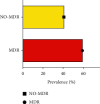Evaluation of Antibiotic Resistance and Biofilm Production among Clinical Strain Isolated from Medical Devices
- PMID: 34426740
- PMCID: PMC8380152
- DOI: 10.1155/2021/9033278
Evaluation of Antibiotic Resistance and Biofilm Production among Clinical Strain Isolated from Medical Devices
Abstract
Microbial biofilms pose a serious threat to patients requiring medical devices (MDs). Prolonged periods of implantation carry a high risk of device-related infections (DRIs). Patients with DRIs often have negative outcomes following the failure of antibiotic treatment. Resistant DRIs are mainly due to the MDs contamination by bacteria producing biofilm. The present study aimed to detect biofilm formation among MD bacterial isolates and to explore their antibiotic resistance profile. The study was conducted on 76 MDs, collected at University Hospital of Campania "Luigi Vanvitelli," between October 2019 and September 2020. Identification of isolates and antibiotic susceptibility testing were performed using Matrix Assisted Laser Desorption Ionization-Time of Flight Mass Spectrometry (MALDI-TOF MS) and Phoenix Becton Dickinson, respectively. Biofilm-forming abilities were assessed using the tissue culture plate (TCP) method. Among the 94 MDs isolated strains, 42.7% were Gram-positive, 40.3% Gram-negative, and 17% Candida species. Among 78 bacterial strains, 43.6% were non-biofilm producers while 56.4% produced biofilms. All biofilm producing isolates were sensitive to a limited spectrum of antibiotic classes. All moderate and strong biofilm producers and 81% of weak biofilm producers were Multidrug Resistance (MDR) strains. In contrast, among non-biofilm producers, only 11.8% were classified as MDR strains. Our results highlighted that Sulfamides and Glycopeptides for the major Gram-positive strains and Fluoroquinolones, Carbapenems, and Aminoglycosides for the most represented Gram-negative isolates could be the most suitable therapeutic choice for most biofilm-DRIs.
Copyright © 2021 Veronica Folliero et al.
Conflict of interest statement
The authors declare no conflicts of interest.
Figures






References
LinkOut - more resources
Full Text Sources
Research Materials
Miscellaneous

